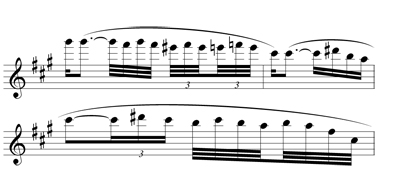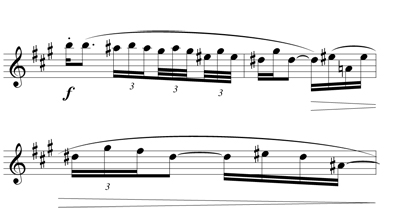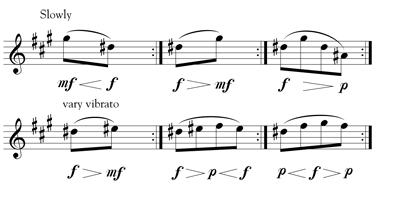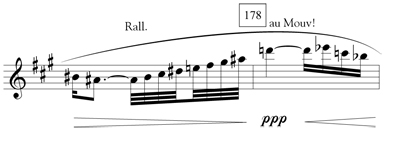This visionary piece of composition is the most important solo in the piece, and the crowning jewel of the ballet. After many auditions and performances, I still approach it with awe. Though the passage is only 26 measures long, the writing is harmonically complex and the atmosphere is difficult to capture. Whether in an audition or a performance, it is not sufficient to just play the notes. To master this solo, you need to understand all aspects of the composition.
The Story
Daphnis and Chloe is based on a novel written by the Greek poet Longos in 2 A.D. Daphnis and Chloe are two children who are abandoned at birth by their parents and raised by shepherds. As they become older, they form a naive but strong attraction. In the course of the story Chloe is abducted by pirates and then rescued through divine intervention by the god Pan. When the couple is joyously reunited, they declare their love, marry, and are recognized by their birth parents.
The Ballet
In 1909 the Russian impresario Sergei de Diaghilev commissioned Maurice Ravel to compose the Daphnis and Chloe Ballet for his Ballets Russes. The premier was June 8, 1912 at the Théâtre du Châtelet in Paris. The premier performance was conducted by Pierre Monteux with choreography by Michel Fokine. Vaslav Nijinsky danced the role of Daphnis and Tamara Karsavina danced the role of Chloe. Stage and costume design was by Léon Bakst.
The Music
Maurice Ravel referred to the 55-minute long composition as a symphonie chorégraphique which Diaghilev said was more symphonie than chorégraphique. The ballet in three parts is scored for piccolo, 2 flutes (2nd doubling piccolo), alto flute, 2 oboes, English horn, E flat clarinet, 2 clarinets, bass clarinet, 3 bassoons, contrabassoon, 4 horns, 4 trumpets, 3 trombones, tuba, timpani and a large percussion section, 2 harps, wordless choir, and strings in 8 parts. In a later production in London in 1914, Diaghilev omitted the chorus parts which infuriated Ravel. Ravel extracted two orchestral suites of which Suite No. 2 has become a staple of the orchestral repertoire. A free score of the complete ballet may be downloaded from www.imslp.com.
First Step
Watch the complete ballet. There is an excellent production online of the Royal Ballet choreographed by Frederick Ashton. This performance was created for the reopening of Covent Garden. The orchestra is the Orchestra of the Royal Opera House. The famous flute solo is on the video D & C No. 8 in this nine-video upload (Part 1: http://www.youtube.com/watch?v=H1XSculJrRs&feature=related, part 8: http://www.youtube.com/watch?v=JfqzjPKm-S8&feature=relmfu). Then listen to the ballet with the orchestral score. ArkivMusic (www.arkivmusic.com) is an online source for vintage recordings. There are over 51 listings for the complete Daphnis and Chloe Ballet and 103 listing of the Daphnis and Chloe Suite No. 2. You may select the recording by orchestra or conductor. Of special interest is a recording conducted by Philippe Gaubert with Marcel Moyse playing principal flute.
The Solo
At the end of Part 2, Chloe has just been rescued from the pirates. After the sunrise beginning at rehearsal 155 the couple is reunited and they decide to enact the story of Pan and Syrinx (rehearsal 172). At rehearsal 175 Chloe disappears into the reeds. Daphnis makes a flute from the reeds and plays a “melancholy air,” during which Chloe reappears and “dances to the accents of the flute” (rehearsal 176). This is the solo discussed in this article. Finally she falls into Daphnis’ arms at rehearsal 187 and at rehearsal 193 he declares his love for her. The ballet ends with a celebratory dance.
For clarity in this article, the 26 measures of this solo have been renumbered 1 – 26, beginning at rehearsal 176. The passage is marked Très Lent, quarter = 66, but should read, eighth = 66. In performance the tempo tends to be a bit slower, so for auditions I have chosen a tempo of e = 58 or 60. The solo flute is accompanied by strings, harp and two horns and the dynamic marking is p.
The solo is in F# minor over a double pedal point of pizzicato F#2 and C#3 in the double basses. The validity of the notes of the opening scale has been questioned through the years. The Durand/Dover score starts on the third note of an F# natural minor scale. Flutist Claude Monteux, whose father Pierre Monteux conducted the premier performance, said his father preferred the D natural and E natural version.
The piano reduction (made by Ravel himself) starts on the third note of an F# melodic minor scale; while in Ravel’s autograph score, the scale is written with a D# and an E natural. (The Ravel autograph score may be found at The University of Texas at Austin Fine Arts Library in the Carlton Lake Collection.) Several conductors have suggested the scale should be played with a D natural and an E#, making the scale an F# harmonic minor scale. Conductor Philippe Gaubert’s 1928 recording, for which Ravel was present, uses the F# melodic minor scale. Technically, I find the F# harmonic minor version most comfortable. You can choose your favorite, but in an audition you will have to play whatever is in the provided music and in performance, consult the Maestro. Check the accompanying errata on page 23 for other discrepancies in the flute part.
The Basics
Start with rhythm. Many players have been dismissed from an audition due to poor rhythmic control in this solo. The pizzicato fourth beat C# and downbeat F# in the basses and then a second beat pizzicato offer a rhythmic structure which gives the passage a dance-like character. The third beat is deemphasized throughout. Avoid rubato because the rhythm is already complex enough. Practice the solo exactly in time using the metronome with special emphasis on holding out the long notes correctly. After a few practices with the metronome, record yourself without the metronome to check your accuracy. The markings suivez le solo and expressive et souple should not be taken as license for excessive liberties especially in an audition.
This is very descriptive music, so use tone and vibrato creatively. Explore the entire range of possibilities and get down deep under the skin of the solo by using the tone as your voice, changing timbre to express what you are saying and varying the vibrato according to a plan. As a general rule start the vibrato at the beginning of the note. Vibrato is a rhetorical device and should not be overstated, substituted for tone, or interfere with rhythm and intonation.
Intonation challenges abound, especially with the B, C#, D# and E# just above the first octave. Lack of tonal focus on these notes can distort intonation. Sometimes we get used to hearing ourselves play out of tune, so it can be difficult to change these habits. Use a tuner, but also establish a good structural tuning sense. For example, start with the high G# in measure 4, then adjust the C# in measure 7 to this, then the octave C# in measure 9, and so forth. Then work on intonation with the secondary, faster notes taking dynamics into account.
The solo explores a large dynamic range. One problem is that the solo begins softly in the high register, so be careful not to play too loud at the start or the dynamics which follow will sound no different. Measures 22-25 deserve special attention.
Harmony and phrasing are interdependent. Playing this solo without at least a general understanding of the harmony is like driving into Boston without a map. Don’t simply resort to a series of banal phrasing clichés because conductors and audition committees know the difference. To stand out from the crowd and sound convincing, you must connect your phrases to the harmony. (Refer to the piano reduction in the Orchestral Excerpts for Flute by Jeanne Baxtresser, Theodore Presser Company) Either record the piano reduction or have a friend play the accompaniment so you can practice playing the solo line while listening vertically to the accompanying chords. Know which chord is coming next and plan out the phrases. None of the chords in the solo resolve in the traditional sense so you must constantly shift tone and dynamics within the larger context of the phrase.
The sound for this solo is that of dominant, minor and half-diminished seventh chords which are created by independently rising chromatic voices in the strings, muted horns, and harps. The dominant creates a traditional instability, the half-diminished chords create a slightly chaotic feeling, and the minor sevenths are more stable and soothing. The pedal pitches of the basses and French horns provide points of reference. Tonal harmony implying F# minor and modal and related keys is veiled in the background. Sometimes, especially later in the solo, the 7th chords clash directly with F#. The chord progression and harmonic rhythm build tension subliminally throughout the solo, reflecting the heightening attraction of Daphnis and Chloe, but there is no peak in the traditional sense. Once you are familiar with the harmony at the piano, focus on your own emotional response to the chord changes supporting the melody. How do the chord transitions make you feel?
The Specifics
Rehearsal 176, Measures 1-11: During the first three measures, carefully subdivide the beat with the conductor. Take a big breath and play the opening scale in measure 3 lyrically and in tempo, with a very fast air column. Using the scale as springboard, fill the flute with air to ensure that the G#6 will be secure.
measures 3-4

Mentally map the movement of the embouchure. Remember the aperture size becomes smaller as you ascend. The dynamic is p, but don’t start the scale too softly or the top G# will sound too loud. This is a study in playing softly and beautifully in the top register. For security first practice the G#6 by itself by overblowing the low register fingering, keeping the throat open. You may also overblow the G#6 with a C#5 fingering. Practice the G#6 alternating the three fingerings. I use the G#6 fingering with right hand middle and ring finger added for a more mellow tone and to bring the pitch down, if necessary.
The harmony in the orchestra is static and veiled for these first six measures of the solo, perhaps representing Pan’s melancholy (meaning something closer to lassitude in Ravel’s day). Play the repeated G#6 in the first phrase with direction, giving a little push approaching the A6 naturals. The G#6 harmonically seeks the A6 natural, symbolizing Daphnis’ yearning for Chloe, but don’t be too passionate yet, it is just the beginning. Keep measures 6-8 together as a unit with a subtle overall phrase concept and don’t stop and start the vibrato too often. You could treat measure 6 as a point of emphasis since it is the third G#6 in a row.
Breathe quickly between the G#6 notes in measure 6 and then drift down the chromatic triplets. The downbeat of measure 7 is not a resolution. Breathe quickly again after the repeated C# notes and then respond to the change of harmony by playing a bit louder or softer and subtly changing the vibrato width and speed. This is a warmer half-diminished sonority as the dissonant D and C naturals move up to consonant D# and C#. Playing softer here draws out the gentler inquiring nature of this turn of phrase. Maybe Chloe approaches Daphnis at this point in her dance. If you crescendo on the 16ths in measure 7 don’t overdo it, as in measure 8 again the chord does not change. It is easy to treat the downbeat as a false arrival point.
measures 6-8

In measures 7-9 good intonation is crucial. Don’t be too flat on the B6 because when you take your left thumb off for the C#6 the flute will have a tendency to roll back. Balance the flute well in your hands. Match the C#s in both octaves. C#6 will have a tendency to be flat and C#5 sharp. Be conscious of the vibrato’s effect on phrasing. For example, if you emphasized the downbeat of measure 8 by using more vibrato, then deemphasize that of measure 9, or vice-versa. Play the falling figuration in measure 8 lightly and imaginatively. Color the C#5 in measures 9-10 gently, with a very open throat and oh shaped vowel to reflect the pleasant harmonic shift.
measures 9-10

Lean gently into each of the 16th notes in measure 9 to lend a sighing quality to the end of the phrase, and do not slow down. The arrival at the C# in measure 10 is a point of low energy. Good breathing so far in the solo now pays off. Breathe between the C# notes in measure 10 and relax here with your most lovely C#. Delay the added crescendo until you hear the chord change in measure 11, and don’t speed up the tempo.
There is a sense of a new mood at measure 12. Ravel is using traditional expectations a bit more strongly as D and A major are implied in the background. Bring out the dynamic contrast by playing the printed mf B5 with a full, focused tone and passionate vibrato. Stay strong into beat 2 of measure 13 when the chord changes to E dominant ninth, keeping the vibrato very warm. Diminuendo all the way to pp going into measure 14 as the harmony rather unexpectedly relaxes again on beat 2. Perhaps Chloe is teasing Daphnis a bit at this point. Gradually accelerate the repeated B5 in measures 14-15, playing them very staccato for clarity and withhold the crescendo until beat 2. You can switch to double-tonguing as the notes get faster, but practice this carefully so the tone does not change. Avoid accenting the sextuplet in measure 15 or rushing the ascending scale at the end of the measure.
The B6 in measure 16 is the loudest point in the solo, as the rude surprise of E# half-diminished 7th chord clashes strongly with the F# in the bass. Slur into the downbeat B6, breathing quickly between the repeated notes. Maintain top intensity through the arc of the phrase to the A# and resist going sharp. Tension in the harmony still remains in measure 17, so don’t start your diminuendo until beat 2. This is another intonation hot spot. Keep a wide interval between D# and E# and visualize the differentiated movements of the embouchure clearly. Breathe quickly after the 3rd beat in measure 17 and focus on staying in tempo. Relax the tone a bit with a slight diminuendo, as the harmony relaxes into a D# minor seventh in measure 18. As you diminuendo, keep working to match the tone color of the D#5 with the notes around it. (Tone Tip: As a general rule for D#5 and E#5, use a slow moving air column, combined with a low, relaxed jaw position, as if playing the notes an octave lower. Make sure you are not covering the embouchure hole too much and maneuver the lower lip forward to prevent flatness of pitch. The throat must be very open and the embouchure relaxed. The softer the note, the further forward the lower lip must be.)
measures 16-18

Practice the notes in measures 17-19 in different patterns for ease of tone production and intonation.

Change the color and go to pp rather suddenly as you approach the retenu legerement (slightly held back) in measure 19. Get your most expensive, intimate tone here. A big breath in measure 17 pays off as you sustain the A# until beat 2 of measure 20. The chord remains the same in measure 20, so don’t overdo the crescendo. Save your air and remain at a slightly slower tempo.
For the scale in measure 21 you need a strategy. Don’t start too softly or slowly and take lots of time towards the top. Move the lower lip gradually forward as you diminuendo to avoid flatness and keep the air moving fast, mapping the embouchure motion. Experiment by grouping this scale by 2s and 4s to discover what works best for you with the rallentando.
measures 21-22

Measure 22 (“au Mouvt., or Tempo 1”)is a special moment in the solo and the most challenging for dynamics, ppp. Work for an ethereal sound as you approach the top of the scale in measure 21. The atmosphere which has built up for the last 21 bars now dissolves with a total change in the accompaniment. Enjoy this moment. I like to use the following fingering for the D6: TH 0234,1004. Roll the flute towards you a bit to prevent sharpness and keep a very fast air column. Withhold the crescendo in measure 22, then keep the jaw relaxed and make a very large crescendo with lots of vibrato in measures 23-24. In measure 23 go back to the standard D6 fingering but match the tuning to the previous D6 and get a big breath without disturbing energy or the rhythm.
When you reach measure 24, sustain the forte a bit, then quickly come back to p while you maintain the air speed and raise the air column by moving the lower lip forward. Don’t roll in here or you will play flat. Take time leaving measure 24 to suspend the tension of this A flat ninth chord (your D natural is a suspension). Keep the tone full in the lower notes as you descend. Make a large retenu in measure 25, but rhythmically pace the end of the bar in relation to the previous 16th-note triplets while continuing to diminuendo. For the final C6, it is very important to keep the pitch up. When you remove the left thumb for this note, keep the flute balanced and do not let it roll back toward you. If you must breathe before measure 26, do it very discreetly.
This solo intimidates many flutists because it requires great tone and rhythm. Remember Stravinsky said the greatest freedom is within the form. With an organized approach, inspiration, and enjoyment from a deeper study of Daphnis and Chloe, mastery of these challenges may come more easily than you thought.
Note: I would like to thank Robert Willoughby, Walfrid Kujala, David Robertson, and Peter Henderson for their valuable insights.
* * *
Characterization Example for Measures 1-16
Measures 1-2: Dreamy, Misty, Distant
Measures 3-5: Yearning, Disoriented
Measures 7-8: Warm, Questioning, Tender
Measures 9-10: Languorous, Desirous, Melancholy
Measure 11: Expectant
Measure 12: Delighted
Measure 13: Hopeful
Measure 14: Hesitant
Measure 15: Insistent, Desperate
Measure 16, Rebuffed, Shocked, Anguished
Design An Interpretation Strategy
On a separate copy of the solo show the following:
1. Working in small sections, shape the longer primary notes and shorter secondary notes, deciding degree of emphasis, dynamic nuance, and direction for each.
2. Plan the following aspects within each area: vibrato use, air speed and direction, aperture size and embouchure position, breathing, attacks, and releases.
3. Designate notes for special timbre changes.
4. At appropriate spots, indicate reminders for execution, such as “keep fingers close to keys.”
Helpful Hints: Making a synthesis of your playing takes time, patience, and ease with the fundamentals. Begin with simple melodies, work on each aspect separately, and then slowly start to blend elements as they become easier and more instinctive. Base your decisions on observations of all aspects of the piece and the character of the passage. Beyond the composer’s printed indications, these elements may include harmony, form, rhythm, and articulation.






